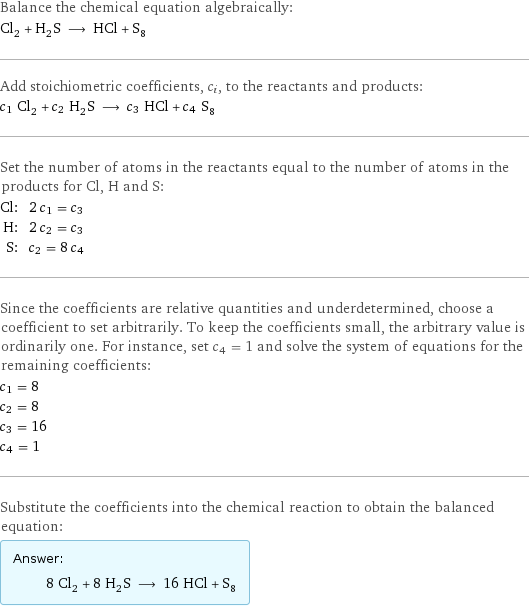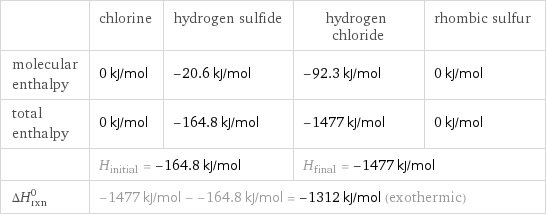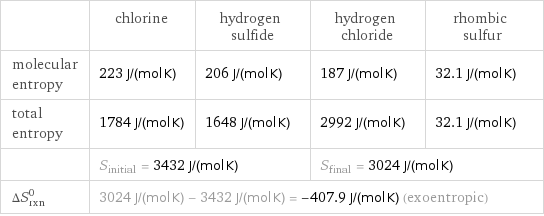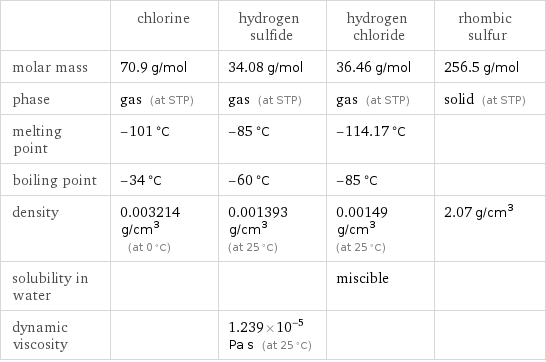Input interpretation

Cl_2 chlorine + H_2S hydrogen sulfide ⟶ HCl hydrogen chloride + S_8 rhombic sulfur
Balanced equation

Balance the chemical equation algebraically: Cl_2 + H_2S ⟶ HCl + S_8 Add stoichiometric coefficients, c_i, to the reactants and products: c_1 Cl_2 + c_2 H_2S ⟶ c_3 HCl + c_4 S_8 Set the number of atoms in the reactants equal to the number of atoms in the products for Cl, H and S: Cl: | 2 c_1 = c_3 H: | 2 c_2 = c_3 S: | c_2 = 8 c_4 Since the coefficients are relative quantities and underdetermined, choose a coefficient to set arbitrarily. To keep the coefficients small, the arbitrary value is ordinarily one. For instance, set c_4 = 1 and solve the system of equations for the remaining coefficients: c_1 = 8 c_2 = 8 c_3 = 16 c_4 = 1 Substitute the coefficients into the chemical reaction to obtain the balanced equation: Answer: | | 8 Cl_2 + 8 H_2S ⟶ 16 HCl + S_8
Structures

+ ⟶ +
Names

chlorine + hydrogen sulfide ⟶ hydrogen chloride + rhombic sulfur
Reaction thermodynamics
Enthalpy

| chlorine | hydrogen sulfide | hydrogen chloride | rhombic sulfur molecular enthalpy | 0 kJ/mol | -20.6 kJ/mol | -92.3 kJ/mol | 0 kJ/mol total enthalpy | 0 kJ/mol | -164.8 kJ/mol | -1477 kJ/mol | 0 kJ/mol | H_initial = -164.8 kJ/mol | | H_final = -1477 kJ/mol | ΔH_rxn^0 | -1477 kJ/mol - -164.8 kJ/mol = -1312 kJ/mol (exothermic) | | |
Entropy

| chlorine | hydrogen sulfide | hydrogen chloride | rhombic sulfur molecular entropy | 223 J/(mol K) | 206 J/(mol K) | 187 J/(mol K) | 32.1 J/(mol K) total entropy | 1784 J/(mol K) | 1648 J/(mol K) | 2992 J/(mol K) | 32.1 J/(mol K) | S_initial = 3432 J/(mol K) | | S_final = 3024 J/(mol K) | ΔS_rxn^0 | 3024 J/(mol K) - 3432 J/(mol K) = -407.9 J/(mol K) (exoentropic) | | |
Equilibrium constant
![Construct the equilibrium constant, K, expression for: Cl_2 + H_2S ⟶ HCl + S_8 Plan: • Balance the chemical equation. • Determine the stoichiometric numbers. • Assemble the activity expression for each chemical species. • Use the activity expressions to build the equilibrium constant expression. Write the balanced chemical equation: 8 Cl_2 + 8 H_2S ⟶ 16 HCl + S_8 Assign stoichiometric numbers, ν_i, using the stoichiometric coefficients, c_i, from the balanced chemical equation in the following manner: ν_i = -c_i for reactants and ν_i = c_i for products: chemical species | c_i | ν_i Cl_2 | 8 | -8 H_2S | 8 | -8 HCl | 16 | 16 S_8 | 1 | 1 Assemble the activity expressions accounting for the state of matter and ν_i: chemical species | c_i | ν_i | activity expression Cl_2 | 8 | -8 | ([Cl2])^(-8) H_2S | 8 | -8 | ([H2S])^(-8) HCl | 16 | 16 | ([HCl])^16 S_8 | 1 | 1 | [S8] The equilibrium constant symbol in the concentration basis is: K_c Mulitply the activity expressions to arrive at the K_c expression: Answer: | | K_c = ([Cl2])^(-8) ([H2S])^(-8) ([HCl])^16 [S8] = (([HCl])^16 [S8])/(([Cl2])^8 ([H2S])^8)](../image_source/6a19a1d25bee5f3e59840c7f80f2bae3.png)
Construct the equilibrium constant, K, expression for: Cl_2 + H_2S ⟶ HCl + S_8 Plan: • Balance the chemical equation. • Determine the stoichiometric numbers. • Assemble the activity expression for each chemical species. • Use the activity expressions to build the equilibrium constant expression. Write the balanced chemical equation: 8 Cl_2 + 8 H_2S ⟶ 16 HCl + S_8 Assign stoichiometric numbers, ν_i, using the stoichiometric coefficients, c_i, from the balanced chemical equation in the following manner: ν_i = -c_i for reactants and ν_i = c_i for products: chemical species | c_i | ν_i Cl_2 | 8 | -8 H_2S | 8 | -8 HCl | 16 | 16 S_8 | 1 | 1 Assemble the activity expressions accounting for the state of matter and ν_i: chemical species | c_i | ν_i | activity expression Cl_2 | 8 | -8 | ([Cl2])^(-8) H_2S | 8 | -8 | ([H2S])^(-8) HCl | 16 | 16 | ([HCl])^16 S_8 | 1 | 1 | [S8] The equilibrium constant symbol in the concentration basis is: K_c Mulitply the activity expressions to arrive at the K_c expression: Answer: | | K_c = ([Cl2])^(-8) ([H2S])^(-8) ([HCl])^16 [S8] = (([HCl])^16 [S8])/(([Cl2])^8 ([H2S])^8)
Rate of reaction
![Construct the rate of reaction expression for: Cl_2 + H_2S ⟶ HCl + S_8 Plan: • Balance the chemical equation. • Determine the stoichiometric numbers. • Assemble the rate term for each chemical species. • Write the rate of reaction expression. Write the balanced chemical equation: 8 Cl_2 + 8 H_2S ⟶ 16 HCl + S_8 Assign stoichiometric numbers, ν_i, using the stoichiometric coefficients, c_i, from the balanced chemical equation in the following manner: ν_i = -c_i for reactants and ν_i = c_i for products: chemical species | c_i | ν_i Cl_2 | 8 | -8 H_2S | 8 | -8 HCl | 16 | 16 S_8 | 1 | 1 The rate term for each chemical species, B_i, is 1/ν_i(Δ[B_i])/(Δt) where [B_i] is the amount concentration and t is time: chemical species | c_i | ν_i | rate term Cl_2 | 8 | -8 | -1/8 (Δ[Cl2])/(Δt) H_2S | 8 | -8 | -1/8 (Δ[H2S])/(Δt) HCl | 16 | 16 | 1/16 (Δ[HCl])/(Δt) S_8 | 1 | 1 | (Δ[S8])/(Δt) (for infinitesimal rate of change, replace Δ with d) Set the rate terms equal to each other to arrive at the rate expression: Answer: | | rate = -1/8 (Δ[Cl2])/(Δt) = -1/8 (Δ[H2S])/(Δt) = 1/16 (Δ[HCl])/(Δt) = (Δ[S8])/(Δt) (assuming constant volume and no accumulation of intermediates or side products)](../image_source/d754970e62f2ce6bc5b282ee391bf7cb.png)
Construct the rate of reaction expression for: Cl_2 + H_2S ⟶ HCl + S_8 Plan: • Balance the chemical equation. • Determine the stoichiometric numbers. • Assemble the rate term for each chemical species. • Write the rate of reaction expression. Write the balanced chemical equation: 8 Cl_2 + 8 H_2S ⟶ 16 HCl + S_8 Assign stoichiometric numbers, ν_i, using the stoichiometric coefficients, c_i, from the balanced chemical equation in the following manner: ν_i = -c_i for reactants and ν_i = c_i for products: chemical species | c_i | ν_i Cl_2 | 8 | -8 H_2S | 8 | -8 HCl | 16 | 16 S_8 | 1 | 1 The rate term for each chemical species, B_i, is 1/ν_i(Δ[B_i])/(Δt) where [B_i] is the amount concentration and t is time: chemical species | c_i | ν_i | rate term Cl_2 | 8 | -8 | -1/8 (Δ[Cl2])/(Δt) H_2S | 8 | -8 | -1/8 (Δ[H2S])/(Δt) HCl | 16 | 16 | 1/16 (Δ[HCl])/(Δt) S_8 | 1 | 1 | (Δ[S8])/(Δt) (for infinitesimal rate of change, replace Δ with d) Set the rate terms equal to each other to arrive at the rate expression: Answer: | | rate = -1/8 (Δ[Cl2])/(Δt) = -1/8 (Δ[H2S])/(Δt) = 1/16 (Δ[HCl])/(Δt) = (Δ[S8])/(Δt) (assuming constant volume and no accumulation of intermediates or side products)
Chemical names and formulas

| chlorine | hydrogen sulfide | hydrogen chloride | rhombic sulfur formula | Cl_2 | H_2S | HCl | S_8 Hill formula | Cl_2 | H_2S | ClH | S_8 name | chlorine | hydrogen sulfide | hydrogen chloride | rhombic sulfur IUPAC name | molecular chlorine | hydrogen sulfide | hydrogen chloride | octathiocane
Substance properties

| chlorine | hydrogen sulfide | hydrogen chloride | rhombic sulfur molar mass | 70.9 g/mol | 34.08 g/mol | 36.46 g/mol | 256.5 g/mol phase | gas (at STP) | gas (at STP) | gas (at STP) | solid (at STP) melting point | -101 °C | -85 °C | -114.17 °C | boiling point | -34 °C | -60 °C | -85 °C | density | 0.003214 g/cm^3 (at 0 °C) | 0.001393 g/cm^3 (at 25 °C) | 0.00149 g/cm^3 (at 25 °C) | 2.07 g/cm^3 solubility in water | | | miscible | dynamic viscosity | | 1.239×10^-5 Pa s (at 25 °C) | |
Units
